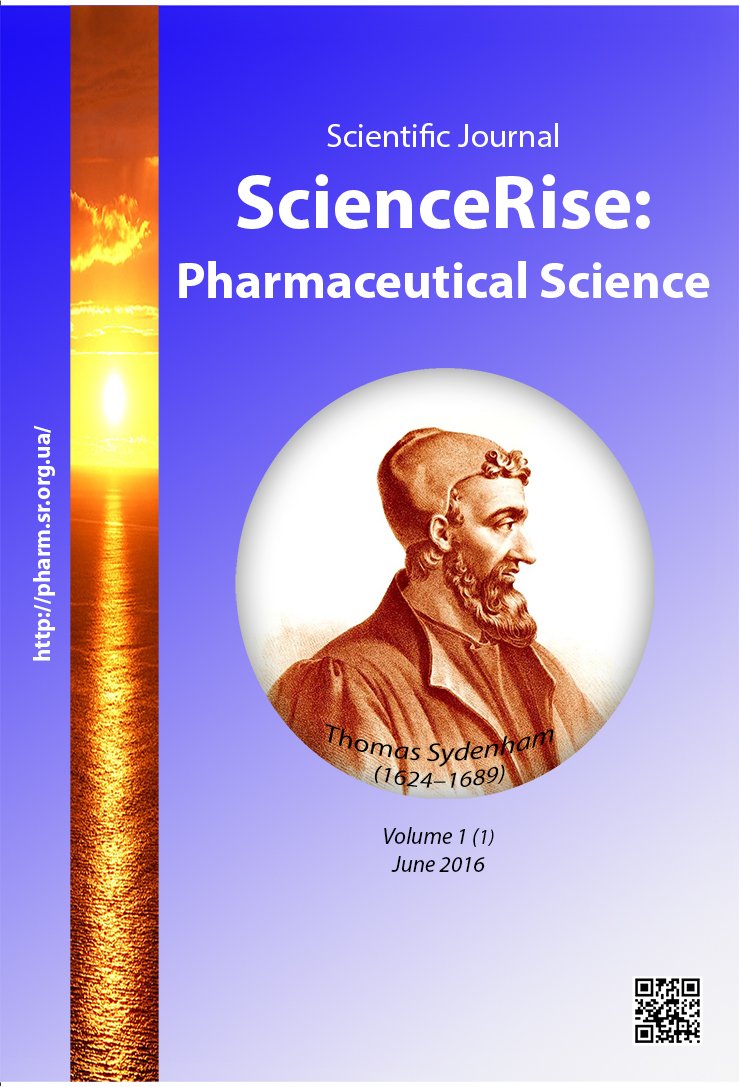Вплив сухих рослинних екстрактів на перебіг пентилентетразолових судом у мишей: результати скринінгу та взаємозвязок «хімічний склад – фармакологічний ефект»
DOI:
https://doi.org/10.15587/2519-4852.2016.71518Ключові слова:
лікарські рослини, екстракти, судоми, скринінг, взаємозв’язок «хімічний склад – фармакологічний ефект»Анотація
Мета. Провести фармакологічний скринінг 48 сухих екстрактів, отриманих із 18 видів рослин 8 родин, протисудомні властивості яких раніше не вивчались, здійснити аналіз хімічного складу екстрактів із виразними анти- та проконвульсивними властивостями, а також оцінити взаємозв’язок між фармакологічним ефектом рослинних препаратів та їх фітохімічним складом.
Методи. На моделі пентилентетразолових судом у мишей було встановлено ефект 48 сухих рослинних екстрактів із різним хімічним складом. Екстракти стандартизували за вмістом алкалоїдів, флавоноїдів та поліфенольних сполук відповідно до вимог Європейської Фармакопеї (ВЕТШХ, ВЕРХ, УЕРХ, ГХ з мас-детектором).
Результати. За інтегральним показником ефективності – зниженню летальності – встановлено, що 11 рослинних екстрактів мають виразні протисудомні властивості, 10 фітопрепаратів діють як проконвульсанти, а інші 27 екстрактів практично не вливають на експериментальні судоми. Визначений зв’язок між фармакологічним ефектом та фітохімічним складом рослин, з яких одержували екстракти, а також видовою приналежністю рослини-хазяїна (для паратизуючого виду – омели білої) та ступенем полярності екстрагенту. Для екстрактів із вираженими анти- та проконвульсивними властивостями визначено їх хімічний склад.
Висновки. Детальний аналіз взаємозв’язку між фітохімічним складом та впливом екстрактів на перебіг судом показав, що протисудомна дія екстрактів найвірогідніше обумовлена високим вмістом рутину, проте для рослин із виразними проконвульсивними властивостями роль окремих груп біологічно активних сполук залишається не визначеною
Посилання
- Kumar, S., Madaan, R., Bansal, G., Jamwal, A., Sharma, A. (2012). Plants and Plant Products with Potential Anticonvulsant Activity – A Review. Pharmacognosy Communications, 2 (1), 3–99. doi: 10.5530/pc.2012.suppl1.2
- Nsour, W. M., Lau, C. B.-S., Wong, I. C. K. (2000). Review on phytotherapy in epilepsy. Seizure, 9 (2), 96–107. doi: 10.1053/seiz.1999.0378
- Pitkänen, A., Schwartzkroin, P. A., Moshé, S. L. (2005). Models of seizures and epilepsy. Amsterdam: Elsevier, 712.
- Tsyvunin, V. V., Shtrygol’, S. Y., Prokopenko, Y. S., Georgiyants, V. A. (2012). The screening investigation of anticonvulsant activity of dry extracts from 8 species of plants of the families Solanaceae, Papaveraceae, Lamiaceae and Polemoniaceae. Clinical Pharmacy, 16 (4), 47–50.
- Akdogan, I., Goksin, N. (2011). Experimental Epilepsy Models and Morphologic Alterations of Experimental Epilepsy Models in Brain and Hippocampus. Underlying Mechanisms of Epilepsy, 4, 269–283. doi: 10.5772/19928
- Tsyvunin, V. V., Shtrygol’, S. Y., Prokopenko, Y. S., Toryanik, E. L. (2014). Experimental defining of anticonvulsant action of perspective phytogenic anticonvulsants. Ukrainian Biopharmaceutical Journal, 3 (32), 45–49.
- Rho, J. M., Sankar, R., Stafstrom, C. E. (2010). Epilepsy: mechanisms, models, and translational perspectives. Boca Raton: CRC Press, 684. doi: 10.1201/ebk1420085594
- Medina, J. H., Viola, H., Wolfman, C. (1997). Overview – Flavonoids: A New Family of Benzodiazepine Receptor Ligands. Neurochemistry Research, 22 (4), 419–425.
- Rang, H. P., Maureen Dale, M. (2003). Pharmacology. Edinburgh: Churchill Livingstone, 797.
- Sweta, V. R., Lakshmi, T. (2015). Pharmacological profile of tropane alkaloids. Journal of Chemical and Pharmaceutical Research, 7 (5), 117–119.
- Gupta, P. C., Sharma, N., Rao, C. V. (2012). A review on ethnobotany, phytochemistry and pharmacology of Fumaria indica (Fumitory). Asian Pacific Journal of Tropical Biomedicine, 2 (8), 665–669. doi: 10.1016/s2221-1691(12)60117-8
- Reza, H. M., Mohammad, H., Golnaz, E. (2009). Effect of methanolic extract of Hyoscymus niger L. on the seizure induced by picritoxin in mice. Pakistan Journal of Pharmaceutical Sciences, 22 (3), 308–312.
- Crawford, P. (2001). CPD – Education and self-assessment: Epilepsy and pregnancy. Seizure, 10 (3), 212–219. doi: 10.1053/seiz.2001.0562
- Holmes, L. B., Harvey, E. A., Coull, B. A., Huntington, K. B., Khoshbin, S., Hayes, A. M., Ryan, L. M. (2001). The Teratogenicity of Anticonvulsant Drugs. New England Journal of Medicine, 344 (15), 1132–1138. doi: 10.1056/nejm200104123441504
##submission.downloads##
Опубліковано
Як цитувати
Номер
Розділ
Ліцензія
Авторське право (c) 2016 Vadim Tsyvunin, Sergey Shtrygol’, Yuliya Prokopenko, Victoriya Georgiyants, Nataliya Blyznyuk

Ця робота ліцензується відповідно до Creative Commons Attribution 4.0 International License.
Наше видання використовує положення про авторські права Creative Commons CC BY для журналів відкритого доступу.









